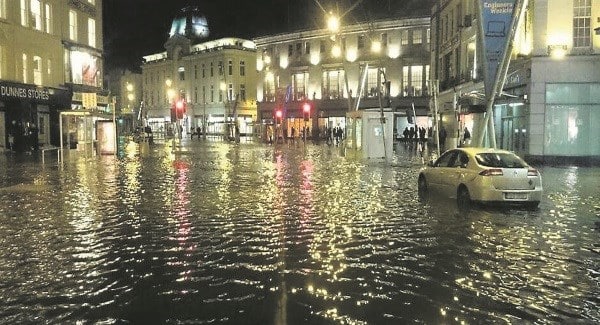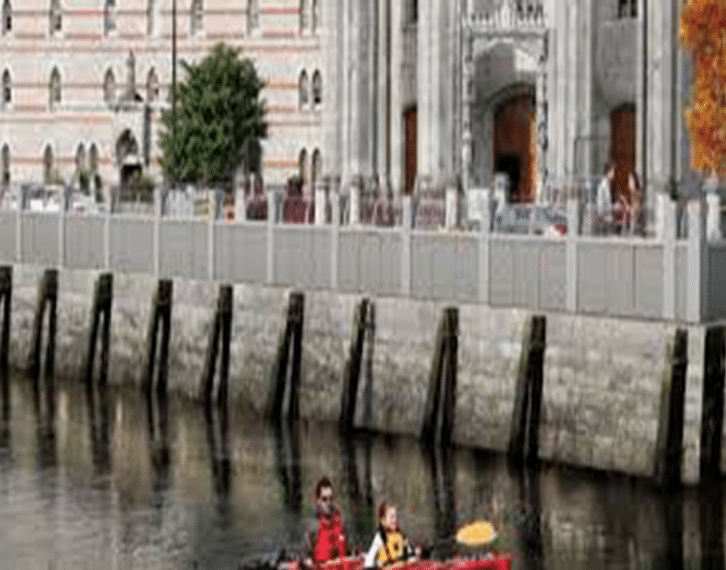The office of Public Works (OPW, the State’s building service) proposes to construct up to 15km of flood defence walls and embankments in Cork City, including dykes, concrete walls and railings throughout the historic centre of the city. The works would be carried out under the Lower Lee (Cork City) Drainage Scheme (Flood Relief) and are an effort to mitigate the effects of climate-change driven flooding which all agree needs to be addressed in Cork.
In some places the OPW walls would cover the entire frontage to the water of 16th, 17th and 18th Century historic quays while in others the new walls (and railings) would be constructed on top of older quays. Clearly the aesthetic and design of the scheme as presented is in stark contrast to the existing historic fabric and could not rationally be considered sensitive to the historic setting. Drawings for the scheme show the effect would be dramatic. The proposals have been viewed as a way of investing in the quays and the historic setting of Cork, and there are those, including some business groups, who want to secure the investment without questioning whether it is necessary or how the project is designed.
However, Save Cork City and a growing number of opponents say that, like the main drainage project, the construction of the scheme would undermine local business in the historic city, destroy heritage and leave a barren landscape in the city centre that would lose the competitive advantage of its special character, over out-of-town locations in the Cork area. It says the widespread construction of drainage walls and pump chambers is ill-conceived in Cork where tampering with ground-water systems could lead to building subsidence and that water will rise within buildings, flooding the city from within as has long been the case, regardless of the works proposed.
HR Wallingford international hydrological engineers, commissioned by Save Cork City, have said overtopping of quay walls after implementation of the OPW scheme could cause serious risk to life and the OPW has confirmed this may happen as early as 2049. Save Cork City say a tidal barrier at Little Island is the most economical and the fastest way to protect Cork. International experts agree, with Delft University saying it is “an interesting and attractive option” to protect the city. Emeritus Professor Philip O’Kane has extensively studied the upstream dams in Cork and, with HR Wallingford which has provided consultancy advice to the ESB over the years and the Port of Cork Authority, confirming that the dams are suitable to protect the city from fluvial flooding with little alteration to current practice or even electricity production.

Save Cork City say the walls scheme is the largest scale planned destruction of heritage in the history of the state. They also say Cork has the largest intact urban Georgian waterway landscape in the World. Cork city has grown for a thousand years as a centre of trade. Its development was heavily influenced by its connections with Northern Europe and the south of England. Early Cork as seen in John Butt’s view of Cork c1740, (Crawford Art Gallery) shows a city of canals and waterways with fine Dutch style gabled, brick buildings. Ireland was a different place back then and Cork connected very fast with other trading cities especially in progressive and innovative Northern Europe.
In 2017 Save Cork City ran an international design competition with a €10,000 prize for the quays of Cork to demonstrate what the city quays could be if sensitively repaired. The jury was chaired by Yvonne Farrell of Grafton Architects a multi-award-winning Irish practice and included Tim Lucas of Pryce Myers Engineers in London. The competition received entries from all over Europe and was won by Henry Harker and Francis Keane. The City Council and OPW largely ignored the exhibition and the results, in what was seen as a punitive response to a genuine effort to improve Cork.
The winning design considers flood defence and provides for a tidal barrier that would cost less than the OPW and City Council scheme. Save Cork City describe the OPW designs as brutal and insensitive to the art of design in historic settings. It says Cork City Council now has an opportunity to repair the damage it inflicted on the city during the darker days of the later 20th Century.
For example as part of the modernisation of the 18th-Century centre the City removed all cobbles from the quaysides, discarding them into the river; and built bridges that prevented boating on the river by being too low. It also demolished much of Cork’s 18th Century building stock. Save Cork City say the destruction has deeply affected the psychology of citizens and wants political support to protect the historic centre of the city and its quay scape.
Cork City Council proposed to start the OPW scheme under a Part 8 process (where a local authority gives citizens an opportunity to comment on proposals). It duly consulted on the first phase of the OPW walls proposal – at Morrison’s Island. Tidal flooding has run into the city centre from low lying Morrison’s Island and protecting the area is seen as a priority for the City Council. Save Cork City says localised OPW walls at Morrison’s Island are a wasteful sticking-plaster-type solution and won’t solve the problem as many more areas are also vulnerable and the city would flood regardless. They question that the Council has not ever provided demountable protection to the area.
The City Council says Morrison’s Island is a stand alone project, yet the OPW say it is not. Save Cork City has raised concerns as to why there has been no tender process for consultancy services for the “separate project”. It claims the City Council and OPW are supporting “project-splitting” methods to push the scheme against substantial public opposition. Clearly, the full project exceeds the size threshold over which an EIA is required.

The City Council received an unprecedented 1491 submissions in response to its part 8 consultation process for the Morrison’s Island phase. Almost every submission was opposed to the scheme. The City Executive seemed to disparage the quality and reliability of the public submissions in its report to the elected members of the City Council which recommended acceptance of the scheme. The report also claimed that heritage had been a priority for the scheme since its inception which opponents say is entirely untrue. The City Council has now given itself permission for the project. However, it is could be vulnerable to judicial review since it has breached the elementary requirement not to split projects into separate applications, and to provide EIA not to itself but as part of a process whereby it applies to An Bord Pleanála.
Save Cork City has criticised the engineering basis for the OPW proposal saying that it is not based on best practice or in line with the EU floods directive. It insists it is simply a drainage scheme designed to funnel fast flowing water through the historic city core.
The OPW says the alternative, Little Island tidal barrier, is in the wrong place but opposition groups see this as an attempt to discredit a simple, ingenious and economical plan that makes the walls redundant and that the OPW had surprisingly never considered.
Save Cork City believes that OPW arguments against the Little Island Tidal Barrier on the grounds of environment, cost, shipping and location are now known to be incorrect by OPW and their consultants including Arup but that no public correction has been made up to now.
Arup are viewed as a progressive international design firm and make reference to excellence and innovation in heritage, community relations, climate change, engineering and fostering an open and progressive culture in their literature. The flood-defence walls proposed for Cork are also clearly contrary to, and damaging of, the reputation of the OPW as protectors of heritage in Ireland. Perhaps this is because the OPW Heritage service has not been involved in the design process in any way.
Save Cork City would like OPW Heritage to help restore the quays of Cork according to national and international guidelines. For the moment OPW Heritage is being compromised by association with OPW Drainage Department in relation to proposals for flood-defence walls in historic Cork.
It is remarkable that the OPW walls propose to stop in the city centre and not protect the docklands or the city to the East. MMC quantity surveyors have said the Walls scheme would cost twice what is proposed by the OPW and up to three times if extended to protect the docklands area. The tidal barrier was priced by HR Wallingford and Delft University at between €110 and€185m, in effect giving sustainable flood protection to a vaste greater area and for half the price.
Save Cork City believes that the economic benefit provided by the Tidal Barrier solution which protects much more of the city in terms of infrastructure and development land would stretch into the billions of Euro.
Flood protection is in its infancy in Ireland, a country always slow to act on climate change. Until now most OPW schemes have been drainage proposals and while walls can be appropriate for localised protection they cannot be credibly applied across an entire country. Erik Kraaij Deputy Director of the Dutch River and Sea Defence Programme, who visited Cork recently, said that flood protection must employ an integrated, sustainable approach of combined methods depending on location.
He cited specific consideration for centres of population, employment and heritage cities in line with the EU Floods Directive. While the Dutch are making room for their rivers and involving landowners in solutions the OPW is walling them off and giving private landowners no opportunity to benefit or get involved in the process.
Cork has shown the downside of the current financial system where any handout of investment no matter how destructive will be accepted by a cash-strapped City. Save Cork City says Cork needs more autonomy to make plans and secure financing and that there needs to be more accountability to citizens in local government.
The group believes a change is still possible and the Morrison’s Island Project could be redesigned if there is a will to listen to the people and to involve OPW Heritage. The threat of walls or no money from Minister ‘Boxer’ Moran is central to the division in the city.
The World Bank says: “A city’s conserved historic core can differentiate that city from competing locations, branding it nationally and internationally.” While the protection of Cork’s maritime heritage drives the group Save Cork City argue for the protection of Cork more often on economic grounds than on any other.
The protection of heritage, the local economy and citizen well being is surely the right choice for a dynamic city whose population is proposed to increase by 125,000 over the next 22 years. The tidal barrier at Little Island, if achievable for Cork, offers the solution required to protect a justifiably proud and culturally rich city.
John Hegarty